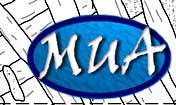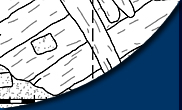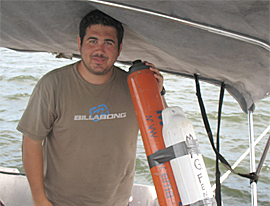
Andy Marr readies the magnetometer for the continuing survey of Pensacola Bay.
It was a very busy Monday on the barge and the first day of the last week of field school. This morning the combination students from the first half of field school came back for a visit, adding five more students to the 12 students, who are on the barge at any one time. The visit gave the combined students from the first half of field school a chance to see what has been uncovered in the units they were working in during their time on EPII. They also got a chance to see the new units that have been excavated and/or are being excavated now.
The supervisors put them to work, increasing our productivity on the barge, making sure that everyone got at least one dive. Some of the combined students helped put in grid material to open up two new units. A new control unit was opened because our original ‘control’ unit had yielded a number of interesting artifacts. With this new control unit, its positive or negative yield of artifacts will help us determine the extent of the artifact scatter from the shipwreck. A new unit was also opened in the stern portion of the wreck. This unit was opened and excavated by both the combination students and current students. In addition, a metal detecting survey was conducted, using three different dive teams. The first two teams finished most of the survey lines, but the third team still conducted a mock survey, so they could also gain knowledge about the use of the underwater metal detector.
With the influx of our combinations students returning from terrestrial the barge was packed. On the other hand, it was a calmer day at our other site, B-Street. A team was sent to continue excavations, which have been ongoing for the last few weeks. While on site, the team opened up a 2 X 2 unit, using the existing units on the site. The unit has been excavated almost completely, all the way down to the various wood pieces strewn throughout the bottom of the hull. One interesting piece found was a half circular piece of wood with a beveled edge, which may have been part of a barrel, but more excavation will be needed this upcoming fall.
Tuesday brought eerily calm and glassy conditions on the bay. Our workday began with high spirits even though we were short handed. Our combo students returned to their terrestrial field schools they had worked for the first half of summer to view the progress they have missed while at their maritime rotation. We were visited by Dr. Harris and his son Hunter, as well as Wayne Abrahamson. Dr. Harris built the scale model of the first Emanuel Point Shipwreck that is now housed in the UWF Archaeology Institute. Wayne is a graduate student and also the Conservation Lab director in the Anthropology program.
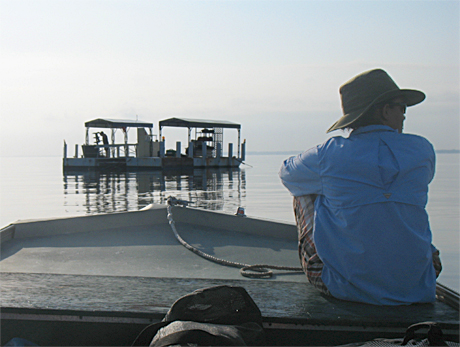
Tuesday brought eerily calm glassy water and excellent working conditions.
Work continued in the stern unit where we are excavating outside of the hull. We are uncovering large amounts of lead sheathing, ballast and concretions. Work was completed on the control unit, completing three levels. From 80 cm of excavation in this unit only two cultural artifacts have been recovered, giving us a better indication of the artifact spread along the bottom of the bay. Supervisor Colleen also led a group of students 100m from the site to take a 1m core. With some fly-by-the-seat thinking the team was able to hammer the tube down and to successfully recover the core.
While Monday was a busy day with lots of people, the barge had a small crew on Wednesday. This was due to the fact that our students were spread over multiple projects which are all trying to finish up throughout this last week of field school. We sent a few students to the lab, who continued to process the artifacts we have uncovered this field season. The lab work has been an important educational tool for us, showing the students the complete excavation process. It has also been very helpful getting a head start on the lengthy work that is needed after the field season.
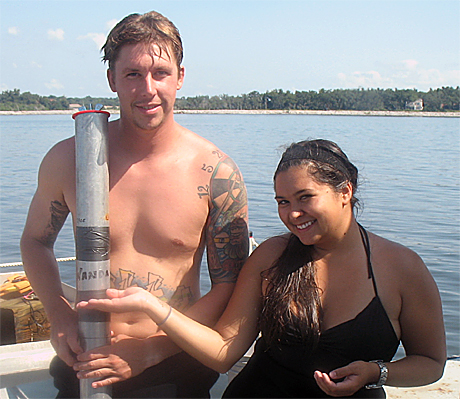
Chad Gulseth and Mercedes holding the core dubbed "Sassy Wanda," a reference to it being taken in the south-western area off of the site.
Out on the barge, there were more coring samples taken by Colleen and crew. They were able to use their skills from the day before to further simplify their task at hand. They swam 100 meters out, took a sample of the sediment, and returned to the barge. In addition to the coring samples, a team was sent to do a metal detecting survey around the area of our ballast pile. Elizabeth set up a grid for the survey and taught Roman how to use the underwater metal detector. A third team was working in the stern unit, which is now our only unit open on site. Lead sheathing was uncovered along the south wall as was a deteriorated piece of wood. The walls in the unit also have some kind of concretion, although since it is within the wall, removing them may not be an option as of right now. If all of this did not keep us busy enough, a group of students went out to survey Pensacola Bay with Tiffany and Greg. The students were then taught how to analyze the data and to determine targets that can be dived later.
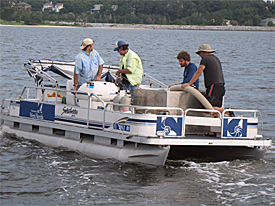
Dean Nones, Wes Perine, Tim Holmes and Matt Gifford head out to work on the Brick Wreck.
Finally, a group went with Dean Nones to the brick wreck. They spent their time upside down and knee deep in the silty meter-deep mud that characterizes the Brick Wreck. They were able to excavate down to the hull in test unit 6. The work done today led Dean to believe the ship is likely listing to one side. An octagonal wooden feature was uncovered as well as a circular piece of timber.
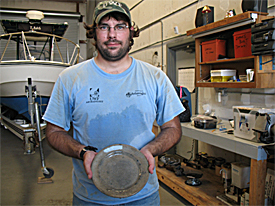
This intact plate was recovered Thursday lying against what could possibly be the windlass of the ship. (Large View).
As our field school experience winds down so does our work on the site. On Thursday only one unit was worked on in the stern of the ship. A piece of wood was uncovered in the west wall and lead sheathing covers the south wall of the unit. Colleen collected her fourth core sample from the southwest in record time, 19 minutes. Hand in hand with the end of field school is gear recovery and clean up. Team 1 performed circle searches under the barge to locate any lost or dropped equipment and found a compass, folding rule, grid material, pvc pipes and a bungee.
The team on the Brick Wreck had a very productive day. They dredged and closed Test Unit 6 and Dean Nones recovered a completely intact plate with the word “hotel” stamped on the back in black lettering. They then began another unit testing the coffer dam style unit which was previously tested at B-Street.
Friday brought the last day of UWF Maritime Field School 2009. It was a bittersweet day filled with goodbyes to new friends we have had the opportunity to work with and get to know this summer. It has been a productive and fun-filled summer. It is a privilege for the students to have a hands-on program like this one in order to learn about maritime archaeology.
Please feel free to contact us if you have any questions or concerns at: mua@keimaps.com.
Return to Project Journal home page.
